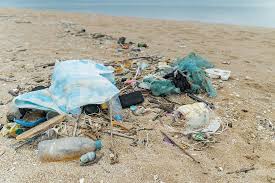Marine Litter Crisis: A Call for Unified Global and National Action

- 11 Apr 2025
Context:
Marine litter, particularly plastic waste, has emerged as a critical global environmental issue. With over 700 marine species affected and microplastics infiltrating food chains, the issue demands both global cooperation and local implementation. Despite India's efforts in solid and plastic waste management, a direct legislative mandate to mitigate marine litter remains absent.
Magnitude of the Crisis
- UNESCO warns: By 2050, plastic volume in oceans could exceed fish biomass.
- Ghost Gear: Lost/discarded fishing gear (nets, traps, lines) poses severe threats:
- 5.7% of nets, 8.6% of traps, and 29% of fishing lines are lost annually (UNEP).
Key Global Frameworks
- MARPOL (Annex V) – In force since 1983, regulates ship-generated garbage disposal in oceans.
- UNCLOS (1994) – Part XII mandates nations to prevent pollution from land-based and sea-based sources, including ghost gear.
- Global Programme of Action (1995) – First UN initiative addressing land-based marine pollution.
- SDGs:
- SDG 14.1: Reduce marine pollution, especially plastics.
- SDG 6.3: Improve water quality via integrated management.
- Honolulu Commitment (2011):
- Reduce land-based debris
- Address sea-based litter
- Clean up accumulated coastal & deep-sea litter
Institutional and Voluntary Actions
- Global Partnership on Marine Litter (GPML, 2012) – UNEP-led initiative uniting stakeholders for source-to-sea plastic mitigation.
- AHEG (2017) – UNEP expert group assessing policy responses for marine litter and recommending frameworks.
- Clean Seas Campaign (2017) – Advocates for elimination of single-use plastics and behaviour change.
- UNEA Resolutions on Marine Litter:
- Adopted in 2014 (UNEA-1), 2016 (UNEA-2), 2017 (UNEA-3), and 2019 (UNEA-4).
- While non-binding, they push for total elimination of litter discharge and evidence-based policymaking.
Scientific Support
- GESAMP (Group of Experts on the Scientific Aspects of Marine Environmental Protection) has, since 2010, guided scientific research on:
- Microplastic sources
- Marine ecosystem impacts
- Monitoring and mitigation strategies
India’s Current Status and Initiatives
- No direct marine litter law or policy yet exists.
- A multi-ministerial body involving MoES, MoST, and MoFAD is drafting a National Marine Litter Action Plan.
- Relevant policies in place:
- Plastic Waste Management Rules, 2016 (includes Extended Producer Responsibility – EPR)
- Solid Waste Management Rules, 2016
- Water (Prevention and Control of Pollution) Act, 1974
Challenges in India
- Fragmented implementation
- Limited monitoring of litter entering marine zones
- Lack of focus on coastal-level execution
Way Forward
- Adopt a national marine litter policy with local implementation mechanisms.
- Strengthen enforcement of international agreements like MARPOL and UNCLOS.
- Promote circular economy models and enhance waste infrastructure.
- Encourage public-private partnerships, community awareness, and behaviour change.
- Support scientific monitoring, research, and innovation.
Conclusion
The transboundary nature of marine litter necessitates global cooperation backed by national accountability. India's next steps must include a dedicated marine litter law, enhanced inter-ministerial coordination, and alignment with international best practices to secure its coastal and marine ecosystems.
